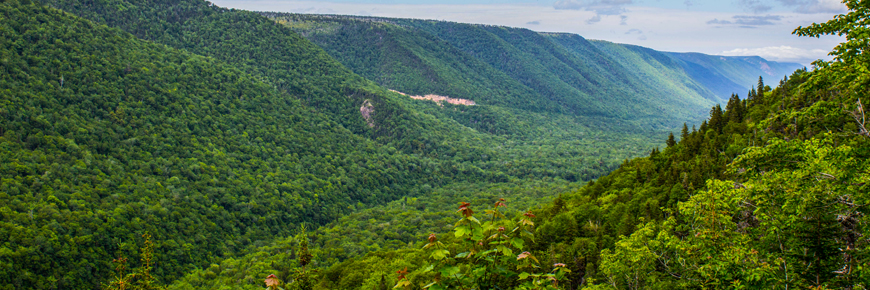
Faults and canyons
Cape Breton Highlands National Park
Faults result from plate tectonics. They occur where two or more continental plates push against one another, pull away from each other or slide alongside one another. As the continental plates slowly drift, pressure builds up along the fault lines. The pressure eventually builds up so much that it causes the masses of rock to slip, suddenly and often violently. We experience these sudden releases of pressure as earthquakes.
There are a number of faults in Cape Breton Highlands National Park but noticeable earthquakes are rare. The faults were probably created long ago when two continental plates met and pushed the sea floor between them upwards to form the Appalachian Mountains. Nowadays, the North American continent is moving westwards, so most of the tectonic activity occurs on the western side of the continent where the Rocky Mountains are still being pushed up today.
Faults often appear on the earth's surface as linear depressions in the land. The most spectacular fault in the park is the Aspy Fault which extends 40 kilometres from the centre of the highlands to the ocean. Before the Atlantic Ocean formed, it may even have connected to faults in Europe like Scotland's Great Glen Fault, home to Loch Ness.
Streams in the park cut down into the plateau, forming deep V-shaped canyons. Running water naturally follows depressions in the land, so several rivers in the park follow fault lines. The eroding action of the water as well as the presence of the fault combine to form very deep canyons. The Aspy River flows down the Aspy Fault line in a very dramatic canyon which can be seen from the Cabot Trail.
Three other valleys in the park that are associated with faults are the Clyburn, Grande Anse and Chéticamp River valleys. All three of these deep canyons have also been carved by glaciers in the past and are therefore U-shaped.
The canyons in Cape Breton Highlands National Park are very important for the ecosystem; they provide the sheltered valleys which the Acadian forest needs to live in. Without the valleys and canyons, the diversity of plants and animals found in northern Cape Breton would probably be much lower than it is.
- Date modified :